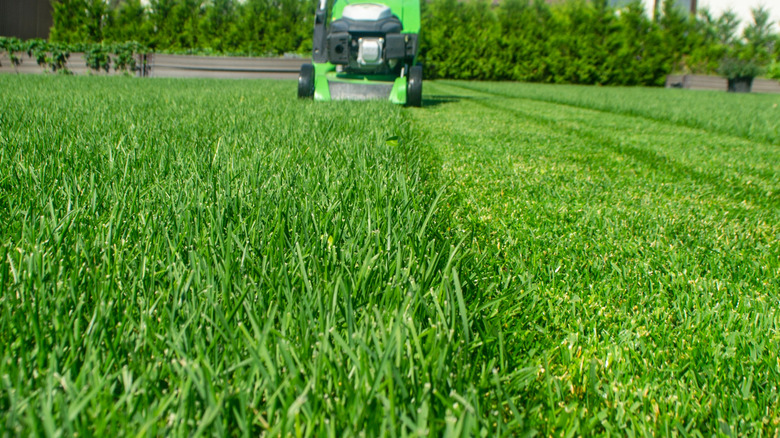Want To Make Your Grass Greener? Be Sure To Check For One Thing Before Mowing
A healthy lawn is a great summer hangout space for good reason — a blanket of grass cools the air, dampens noise, and produces oxygen. A regular maintenance schedule is almost all you need for a lush, green yard. But if the grass in your faithfully fertilized, precisely watered lawn look raggedy and start to turn brownish after mowing, you may have forgotten one basic, but often overlooked, rule of healthy lawn care: sharpening your mower blades. Dull blades on your lawnmower may be damaging the grass.
You could cause physical harm to the grass directly from dull mower blades or set off an overall decline in the health of the lawn. The grass blades will look ragged along the edge and may appear a grayish-brownish color. Rotary and reel mower blade sharpening should be part of your routine. Depending on the type of grass you have, rotary blades like the ones on your gas or electric mower should be sharpened at least every two months. Fast-growing grasses like perennial ryegrass that you mow more often or tough grasses such as zoysia that take a toll on your equipment might make the blade become dull more quickly.
You could also cause harm by cutting too much of the blade off each time you mow. The rule of thumb for keeping your lawn healthy is to only remove the top third of the blades of grass. For instance, if you prefer your grass to be 3 inches tall, the best time to mow your lawn is when it reaches 4 inches tall. You may need to change the blade setting on your mower to maintain this height.
Sharpening a lawn mower blade
Sharpening a mower blade is a straightforward process — remove the spark plug before you begin so the engine doesn't start accidentally. Then, remove the blade from the mower by unscrewing it from the housing, and use a vise to hold it in place while you clean and sharpen it. You'll need an angle grinder to smooth the edges of the blade. Make sure the blade is balanced before you put it back on the mower. You can check the balance by spinning the blade on the end of a nail or similar item to make sure it spins smoothly and make adjustments as necessary.
The blade sharpening process is the same for push mowers and riding mowers. Generally, the blades of reel mowers — the nonmotorized kind you push around the yard — need to be sharpened every two years. While there are kits for sharpening the blades of a reel mower at home, this is a job best done by a professional because the reel mower blade system is more complicated — you could ruin the mower if you do it incorrectly.
If you don't want to sharpen the blade or take it to be sharpened, you can simply replace the blade. Make sure you buy the right part because not all mower blades are interchangeable. Before you throw out the packaging your new mower came in, check to see if it came with a spare blade. Get in the habit of cleaning the blade regularly to keep your mower in tip-top shape — remove accumulated dirt and clippings under the mower deck when you sharpen the blade.

